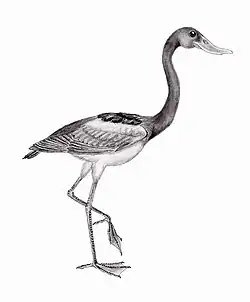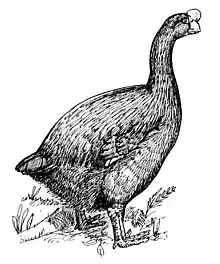Long-tailed duck
The long-tailed duck (Clangula hyemalis), formerly known as the oldsquaw, is a medium-sized sea duck that breeds in the tundra and taiga regions of the arctic and winters along the northern coastlines of the Atlantic and Pacific Oceans. It is the only member of the genus Clangula.
| Long-tailed duck | |
|---|---|
 | |
| Non-breeding male | |
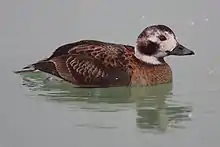 | |
| Female | |
| Scientific classification | |
| Domain: | Eukaryota |
| Kingdom: | Animalia |
| Phylum: | Chordata |
| Clade: | Dinosauria |
| Class: | Aves |
| Order: | Anseriformes |
| Family: | Anatidae |
| Genus: | Clangula Leach, 1819 |
| Species: | C. hyemalis |
| Binomial name | |
| Clangula hyemalis | |
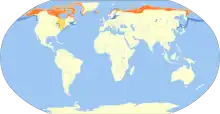 | |
| Synonyms | |
| |
_breeding_male_Oppdal.jpg.webp)
Taxonomy
The long-tailed duck was formally described by the Swedish naturalist Carl Linnaeus in 1758 in the tenth edition of his Systema Naturae. He placed it with all the other ducks in the genus Anas and coined the binomial name Anas hyemalis.[2] Linnaeus cited the English naturalist George Edwards's description and illustration of the "Long-tailed duck from Hudson's-Bay" that had been published in 1750 in the third volume of his A Natural History of Uncommon Birds.[3] This duck is now the only species placed in the genus Clangula that was introduced in 1819 to accommodate the long-tailed duck by the English zoologist William Leach in an appendix to John Ross's account of his voyage to look for the Northwest Passage.[4][5][6] The genus name Clangula is a diminutive of the Latin clangere meaning "to resound". The specific epithet hyemalis is Latin meaning "of winter".[7] The species is considered to be monotypic: no subspecies are recognised.[6]
In North American English it is sometimes called oldsquaw, though this name has fallen out of favour. Some biologists have also feared that this name would be offensive to some Native American tribes involved in the conservation effort.[8][9][10][11][12] The American Ornithologists' Union stated that "political correctness" was not sufficient to change the name, but "to conform with English usage in other parts of the world", it officially adopted the name "Long-tailed Duck".[13]
An undescribed congener is known from the Middle Miocene Sajóvölgyi Formation (Late Badenian, 13–12 Mya) of Mátraszőlős, Hungary.[14]
Distribution
Long-tailed ducks breed on tundra across northern Eurasia (in Russian Siberia, Kamchatka, and Karelia, for example), the Faroe Islands, Finland, parts of southern Greenland, Iceland, Norway, as well as across northern North America (Alaska and northern Canada).
In winter, they are found on and near large bodies of seawater, such as the Northern Pacific Ocean, the North Atlantic Ocean, Hudson Bay and the American Great Lakes.
Description
.jpg.webp)
Adults have white underparts, though the rest of the plumage goes through a complex moulting process. The male has a long pointed tail (10 to 15 cm (3.9 to 5.9 in) long) and a dark grey bill crossed by a pink band. In winter, the male has a dark cheek patch on a mainly white head and neck, a dark breast and mostly white body. In summer, the male is dark on the head, neck and back with a white cheek patch. The female has a brown back and a relatively short pointed tail. In winter, the female's head and neck are white with a dark crown. In summer, the head is dark. Juveniles resemble adult females in autumn plumage, though with a lighter, less distinct cheek patch.
| Standard Measurements[15][16] | |
|---|---|
| length | 440–600 mm (17.5–23.5 in) |
| weight | 740 g (1.63 lb) |
| wingspan | 710 mm (28 in) |
| wing | 209–228 mm (8.2–9.0 in) |
| tail | 165–237 mm (6.5–9.3 in) |
| culmen | 26–30 mm (1.0–1.2 in) |
| tarsus | 34–38 mm (1.3–1.5 in) |
The males are vocal and have a musical yodelling call ow, ow, owal-ow.
Behaviour

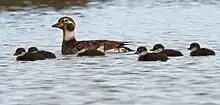
_14.jpg.webp)
Breeding
Their breeding habitat is in tundra pools and marshes, but also along sea coasts and in large mountain lakes in the North Atlantic region, Alaska, northern Canada, northern Europe, and Russia. The nest is located on the ground near water; it is built using vegetation and lined with down. They are migratory and winter along the eastern and western coasts of North America, on the Great Lakes, coastal northern Europe and Asia, with stragglers to the Black Sea. The most important wintering area is the Baltic Sea, where a total of about 4.5 million gather. As of 2022 it has also been breeding in parts of Western Europe, such as on the Marker Wadden in The Netherlands.
Food and feeding
The long-tailed duck is gregarious, forming large flocks in winter and during migration. They feed by diving for mollusks, crustaceans and some small fish. Although they usually feed close to the surface, they are capable of diving to depths of 60 m (200 ft). According to the Audubon Society Field Guide to North American Birds they can dive to 80 fathoms (146 metres or 480 feet). They are the only ducks that use their wings to dive, which gives them the ability to dive much deeper than other ducks.
Status
The long-tailed duck is still hunted across a large part of its range. There has been a significant decline in the number of birds wintering in the Baltic Sea, partly due to their susceptibility to being trapped in gillnets. For these reasons the International Union for Conservation of Nature (IUCN) has categorised the long-tailed duck as vulnerable.[1] It is one of the species to which the Agreement on the Conservation of African-Eurasian Migratory Waterbirds (AEWA) applies.[17]
References
- BirdLife International (2018). "Clangula hyemalis". IUCN Red List of Threatened Species. 2018: e.T22680427A132528200. doi:10.2305/IUCN.UK.2018-2.RLTS.T22680427A132528200.en. Retrieved 11 November 2021.
- Linnaeus, Carl (1758). Systema Naturae per regna tria naturae, secundum classes, ordines, genera, species, cum characteribus, differentiis, synonymis, locis (in Latin). Vol. 1 (10th ed.). Holmiae (Stockholm): Laurentii Salvii. p. 126.
- Edwards, George (1750). A Natural History of Uncommon Birds. Vol. Part III. London: Printed for the author at the College of Physicians. p. 156 Plates 156.
- Leach, William Elford (1819). Ross, John (ed.). A Voyage of Discovery made under the orders of the Admiralty in her Majesty's ships Isabella and Alexander, for the purpose of exploring Baffin's Bay, and enquiring into the probability of a North-West passage. London: John Murray. Appendix II, p. 48.
- Mayr, Ernst; Cottrell, G. William, eds. (1979). Check-List of Birds of the World. Vol. 1 (2nd ed.). Cambridge, Massachusetts: Museum of Comparative Zoology. p. 492.
- Gill, Frank; Donsker, David; Rasmussen, Pamela, eds. (July 2021). "Screamers, ducks, geese & swans". IOC World Bird List Version 11.2. International Ornithologists' Union. Retrieved 1 December 2021.
- Jobling, James A. (2010). The Helm Dictionary of Scientific Bird Names. London: Christopher Helm. pp. 110, 197. ISBN 978-1-4081-2501-4.
- Though squaw originated as a word simply meaning "young woman" in the Massachusett and related Algonquian languages, it is now considered offensive by many Native Americans and is labelled as such in modern dictionaries.
- "Secretary Haaland Takes Action to Remove Derogatory Names from Federal Lands" (Press release). U.S. Department of the Interior. 19 November 2021. Retrieved 20 November 2021.
Secretarial Order 3404 formally identifies the term "squaw" as derogatory and creates a federal task force to find replacement names for geographic features on federal lands bearing the term. The term has historically been used as an offensive ethnic, racial, and sexist slur, particularly for Indigenous women.
- Vowel, Chelsea (2016). "Just Don't Call Us Late for Supper - Names for Indigenous Peoples". Indigenous Writes: A Guide to First Nations, Métis & Inuit Issues in Canada. Winnipeg, Manitoba, Canada: Highwater Press. p. 7. ISBN 978-1553796800.
Let's just agree the following words are never okay to call Indigenous peoples: savage, red Indian, redskin, primitive, half-breed, squaw/brave/papoose.
- National Museum of the American Indian (2007). Do All Indians Live in Tipis?. New York: HarperCollins. ISBN 978-0-06-115301-3.
- Mathias, Fern (December 2006). "SQUAW - Facts on the Eradication of the "S" Word". Western North Carolina Citizens For An End To Institutional Bigotry. American Indian Movement, Southern California Chapter. Archived from the original on 2002-08-02. Retrieved 2018-01-04.
Through communication and education American Indian people have come to understand the derogatory meaning of the word. American Indian women claim the right to define ourselves as women and we reject the offensive term squaw.
- American Ornithologists' Union (2000). "Forty-second supplement to the American Ornithologists' Union Check-list of North American Birds". The Auk. 117 (3): 847–858. doi:10.1642/0004-8038(2000)117[0847:fsstta]2.0.co;2.
- Gál, Erika; Hír, János; Kessler, Eugén; Kókay, József (1998–1999). "Középsõ-miocén õsmaradványok, a Mátraszõlõs, Rákóczi-kápolna alatti útbevágásból. I. A Mátraszõlõs 1. lelõhely" [Middle Miocene fossils from the sections at the Rákóczi chapel at Mátraszőlős. Locality Mátraszõlõs I.] (PDF). Folia Historico Naturalia Musei Matraensis (in Hungarian). 23: 33–78. Archived from the original (PDF) on 2011-07-21. Retrieved 2007-02-06.
- Godfrey, W. Earl (1966). The Birds of Canada. Ottawa: National Museum of Canada. p. 72.
- Sibley, David Allen (2000). The Sibley Guide to Birds. New York: Knopf. p. 97. ISBN 0-679-45122-6.
- "Species". Agreement on the Conservation of African-Eurasian Migratory Waterbirds (AEWA). Retrieved 14 November 2021.


